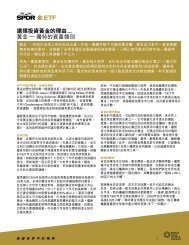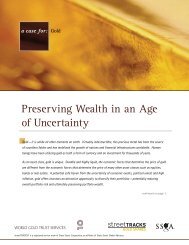You also want an ePaper? Increase the reach of your titles
YUMPU automatically turns print PDFs into web optimized ePapers that Google loves.
In addition, despite gold’s return being adjusted downward to4%, gold’s low correlation with other reserve assets resulted inthe optimiser finding statistical significance in a gold allocation. 9Finally, as illustrated in Chart 1, the lowest risk portfolio did, infact, skew allocations toward dollar assets, allocating 92.2% ofthe portfolio to US agencies and US Treasuries, due substantiallyto their lower dollar-based volatilities.Results from a domestic-currency perspectiveThe results of nine distinct optimisation analyses in emergingmarketcurrencies show that allocations to gold are significantlyhigher in each currency examined relative to the allocationsuggested by a US-dollar analysis. Indeed, optimising a typicalemerging-market central-bank portfolio from a domesticcurrencyperspective for the sample of nine revealed that theUS dollar-based optimisation consistently under-allocated togold. The optimal gold allocation ranged from 2.4% to 25.8%,with a median gold allocation for the group of between 8.4%and 10%, 10 as outlined in Chart 2. In all currencies examined,reserve portfolios exhibited improved risk-adjusted returnswhen gold was added to the portfolio.The stability of gold, and why higher allocationsmay be optimalAnother key finding was that gold exhibited relatively stablevolatility when measured across a number of emerging-marketcurrencies, in contrast to other primary reserve assets suchas US Treasuries, European sovereign debt, Japanese JGBs,and UK gilts. This stability is underpinned by gold’s negativecorrelation with the US dollar and supports higher optimalallocations to gold for most emerging-market central banks.Comparing the optimal allocation to gold from a US dollarand domestic-currency perspective illustrates one of gold’sintriguing qualities – and helps explain why, from a domesticcurrencyperspective, gold allocations should be higher in allnine currencies. The result is based on gold’s behaviour, bothas an asset and a currency. In US dollar terms, gold has thelowest information ratio and the highest volatility relative to allother reserve assets. However, when examined in each of theseselected emerging-market currencies, gold’s information ratio(while still the lowest) was far less affected by changes in thenuméraire than other reserve assets.9 <strong>Gold</strong> was statistically significant in 47 of 51 output portfolios at the 25% percentile level or at a 75% confidence level.10 The majority of the results were significant at the 5% level. Furthermore, the minimum-risk portfolios for seven of the nine currencies were statisticallysignificantly different from the minimum-risk portfolio conducted in US-dollar terms. Only the Korean-won and Polish-zloty portfolios were not statisticallysignificantly different.<strong>Gold</strong> <strong>Investor</strong> | Risk management and capital preservation










